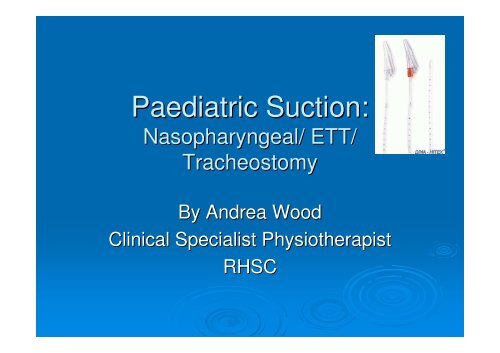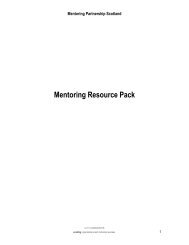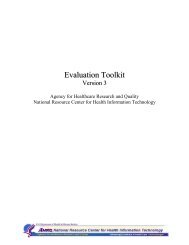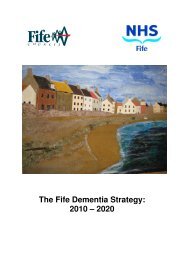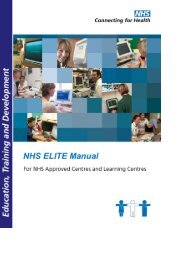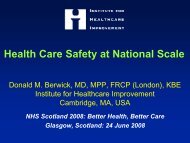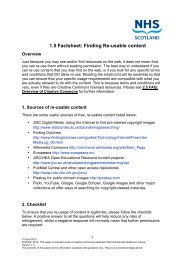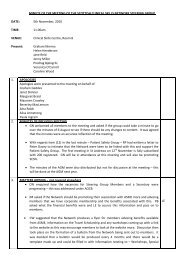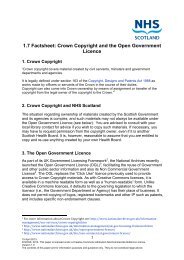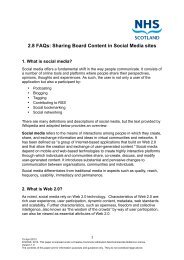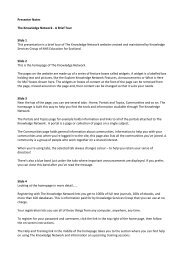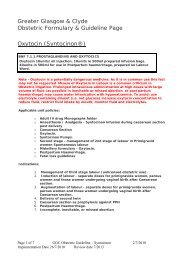Paediatric Suction:
Paediatric Suction:
Paediatric Suction:
You also want an ePaper? Increase the reach of your titles
YUMPU automatically turns print PDFs into web optimized ePapers that Google loves.
<strong>Paediatric</strong> <strong>Suction</strong>:<br />
Nasopharyngeal/ ETT/<br />
Tracheostomy<br />
By Andrea Wood<br />
Clinical Specialist Physiotherapist<br />
RHSC
Indications<br />
Audible secretions, unable to clear themselves.<br />
Inspiratiroy Crackles on Auscultation.<br />
Increased signs of Respiratory Distress.<br />
Palpable secretions.<br />
Reduced O2O<br />
Saturations<br />
Ventilated – Raised PIP, ETCO2 or reduced volumes.<br />
Audible secretion on Manual ventilation in a ventilated<br />
child.
CONTRAINDICATION/CAUTIONS<br />
Coagulpathy.<br />
Patient expectorating independently.<br />
Stridor (if not intubated)<br />
Cardiovascular instability.<br />
Nasal suction in patients with CSF Leak<br />
Nasal <strong>Suction</strong> in patients with facial fractures/trauma.<br />
Patients with raised ICP.
COMPLICATIONS OF<br />
SUCTIONING<br />
Complications<br />
• Hypoxia<br />
• Vaso-vagal – bradycardia, arrythmia, hypoxia,<br />
cardiorespiratory arrest.<br />
• Actelectasis<br />
• Pneumothorax<br />
• Altered intracranial pressure<br />
• Introduction of infection<br />
• Mucosal trauma<br />
Reduced Risk<br />
• Pre and Post Oxygenation. Careful monitoring<br />
throughout.<br />
• Pre and Post Oxygenation. Monitoring throughout.<br />
Shallow suction.<br />
• Pre and Post Oxygenation. Check vacuum<br />
pressures. Maximum of 5 seconds of suction applied.<br />
Correct catheter size used.<br />
• Correct technique.<br />
• Pre and Post Oxygenation. Correct vacuum pressure<br />
applied.<br />
• Avoid contamination of the catheter or site of suction.<br />
• Correct catheter size used. Correct vacuum pressure<br />
applied. Correct technique (e.g. shallow suction)<br />
used.
CATHETER SIZE<br />
Endotracheal/Tracheostomy<br />
Size of tube x 2 = size of catheter (Fg(<br />
Fg)<br />
e.g. ETT size 4 x 2 = 6 Fg catheter to be<br />
used<br />
Naso/oropharyngeal<br />
Newborn = 6 Fg<br />
6 months – 10years = 6 – 8 Fg<br />
>10 years = 10 Fg
RECOMMENDED PRESSURES<br />
Neonate = 50-80 mmHg or 6-10KPa6<br />
Infant -55 yrs = 60 -100 mmHg or 8-138<br />
KPa<br />
5 -15 yrs = 60 – 100 mmHg or 8 -13<br />
KPa<br />
> 15yrs = 120 mmHg or 16 -20<br />
KPa
Technique<br />
Deep <strong>Suction</strong> – Catheter passed down ETT to<br />
resistance felt then withdrawn slightly before<br />
applying suction.<br />
Shallow <strong>Suction</strong> – Catheter is only passed 0.5<br />
– 1.0 cms beyond ETT/ Tracheostomy.<br />
Cochrane Review (2006) found no evidence<br />
from RCT comparing the risk and benefits<br />
between the 2 though recognise anecdotal<br />
evidence.
NP SUCTION<br />
Measuring Depth – Nose to ear.<br />
Technique – In babies and small children<br />
angle catheter backwards and towards<br />
opposite ear. In older children catheter<br />
angled up and towards opposite eye you<br />
may need lubrication.
SALINE INSTILLATION<br />
Adequate fluid balance/ Hydration<br />
Adequate Humidification.<br />
If instilling saline:<br />
- 0.5 mls in babies and infants<br />
-1.0<br />
mls – 2.0 mls in older children
OUTCOMES<br />
Auscultation<br />
SpO2<br />
Respiratory Pattern<br />
Ventilatory Requirements
REFERENCES<br />
Glass, C & Grap, , M (1995) Ten tips for Safer <strong>Suction</strong>ing. American Journal<br />
of Nursing, , pp52-53.<br />
53.<br />
Know, A (1993) Performing endotracheal suction on children: a literature<br />
review and implications for nursing practice. Int. and Crit. Care Nursing,<br />
9,pp48-54.<br />
Pritchard, M et al (2006) Preoxygenation for tracheal suctioning in<br />
intubated, , ventilated newborn infants (review). The Cochrane Library, , no.2.<br />
Runton, , N (1992) <strong>Suction</strong>ing artificial Airways in Children: Appropriate<br />
technique. <strong>Paediatric</strong> Nursing, , 18(2) pp115-118.<br />
118.<br />
Raymond, S (1995) Normal saline instillation before suctioning: Helpful or<br />
harmful? Am. J. of Critical Care,4(4), pp267-271.<br />
271.<br />
Spence, K et al (2006) Deep versus shallow suction of endotracheal tubes<br />
in ventilated neonates and young infants. The Cochrane Library, , no.1,<br />
(CD003309).<br />
Wilson, M (2005) Tracheostomy management, <strong>Paediatric</strong> Nursing. . 17,3, 38-<br />
44.


